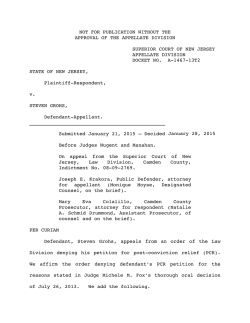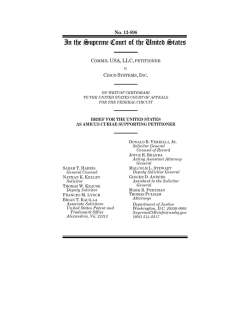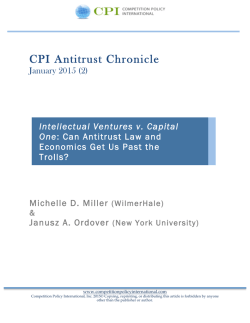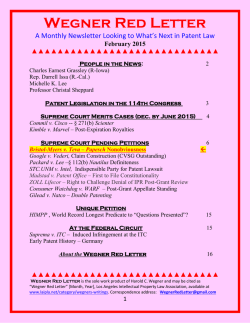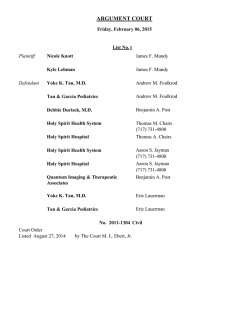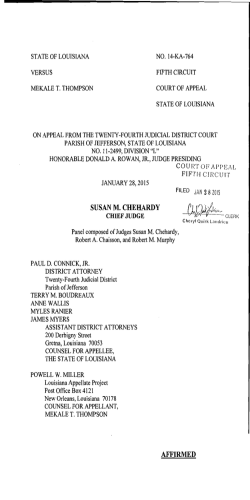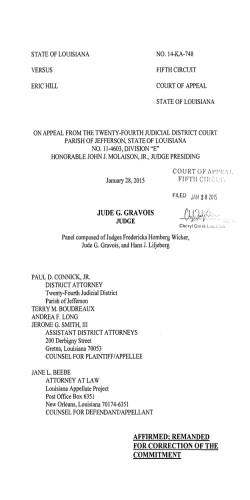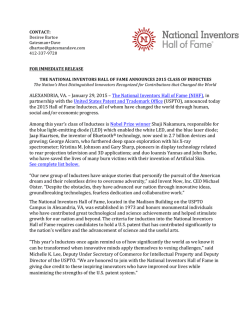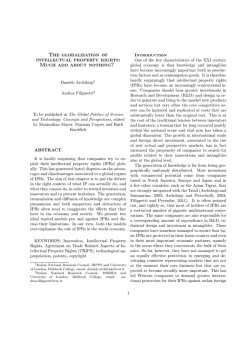
Gilead Sciences
No. 13-896 In the Supreme Court of the United States COMMIL USA, LLC, Petitioner, v. CISCO SYSTEMS, INC., Respondent. On Writ of Certiorari to the United States Court of Appeals for the Federal Circuit BRIEF OF AMICUS CURIAE GILEAD SCIENCES, INC. IN SUPPORT OF PETITIONER CRAIG E. COUNTRYMAN Fish & Richardson P.C. 12390 El Camino Real San Diego, CA 92130 (858) 678-5070 JONATHAN E. SINGER Counsel of Record Fish & Richardson P.C. 3200 RBC Plaza 60 South Sixth Street Minneapolis, MN 55402 (612) 335-5070 Counsel for Amicus Curiae ii TABLE OF CONTENTS Page INTEREST OF AMICUS CURIAE ............................ 1 INTRODUCTION ........................................................ 2 ARGUMENT................................................................ 4 I. A Belief in Noninfringement or Invalidity Should Not Preclude Inducement Liability. ......... 4 A. Section 271(b) Was Derived from A Common Law Doctrine That Did Not Require Knowledge of Wrongdoing. ................ 4 B. This Court’s Precedent Does Not Require a Departure From the Common Law Rule. ........................................................ 10 C. The Federal Circuit’s Rule Conflicts With the Tort Principles Upon Which § 271(b) Was Based. ....................................... 15 II. The Federal Circuit’s Departure from the Common Law Rule Creates Serious Problems for Innovators. ..................................... 16 A. The Federal Circuit’s Rule Conflicts With Congress’s Directive That Patents Needed to Protect Investments in Drug Development Should be Enforceable. ............ 16 B. The Federal Circuit’s Rule Invites Difficult Mini-trials about State of Mind. ............................................................... 23 CONCLUSION .......................................................... 26 TABLE OF AUTHORITIES Page(s) Cases Aro Mfg. Co. v. Convertible Top Replacement Co., 377 U.S. 476 (1964) (Aro II)........................... 12, 14 Barlow v. United States, 32 U.S. 404 (1833) ................................................ 24 Commil USA, LLC v. Cisco Systems, Inc., 720 F.3d 1361 (Fed. Cir. 2013) ............................ 10 Glaxo, Inc. v. Novopharm., Ltd., 110 F.3d 1562 (Fed. Cir. 1997) ............................ 17 Global-Tech Appliances, Inc. v. SEB SA, 131 S. Ct. 2060 (2011) .................................. passim Jerman v. Carlisle, McNellie, Rini, Kramer & Ulrich LPA, 130 S.Ct. 1605 (2010) ....................................... 6, 25 Knorr-Bremse v. Dana Corp., 383 F.3d 1337 (en banc) ....................................... 25 Metro-Goldwyn Mayer Studios, Inc. v. Grokster, Ltd., 545 U.S. 913 (2005) .................................. 10, 11, 12 Microsoft Corp. v. i4i Ltd. P’ship, 131 S. Ct. 2238 (2011) .......................................... 15 iv Russello v. United States, 464 U.S. 16 (1983) ................................................ 14 Sanofi-Aventis v. Apotex, Inc., 659 F.3d 1171 (Fed. Cir. 2011) ............................ 23 In re Seagate, 497 F.3d 1360 (Fed. Cir. 2007) (en banc) ..................................................................... 25 Webster v. Fall, 266 U.S. 507 (1925) .............................................. 13 Statutes 21 U.S.C. § 355(j)(2)(A)(vii)(IV) ................................ 17 35 U.S.C. § 154 .......................................................... 21 35 U.S.C. § 271 .................................................. passim 35 U.S.C. § 282 .................................................... 15, 18 35 U.S.C. § 284 .......................................................... 25 35 U.S.C. § 298 .......................................................... 25 35 U.S.C. §§ 302, 303 ................................................ 20 Legislative History 80th Cong., 2nd Sess., ser. 21, at 3 (1948) (statement of Giles S. Rich) ..................... 16 v Contributory Infringement: Hearings on H.R. 3866 before Subcomm. No. 4 of the H. Comm. on the Judiciary, 81st Cong. 83 (1949) ...................................................... 9 H. Rep. No. 1923, 82nd Cong., 2d Sess, at 9 (1952) (1952) ................................................... 5 S. Rep. No. 1979, 82nd Cong., 2d Sess. at 8 (1952)............................................................... 5 Other Authorities AIPLA, Report of the Economic Survey, available at http://bit.ly/1yF9L9h ....................... 26 Benjamin N. Roin, Unpatentable Drugs and the Standards of Patentability, 87 TEX. L. REV. 503, 512-13 (2009) ...................... 18 Congressional Budget Office, RESEARCH AND DEVELOPMENT IN THE PHARMACEUTICAL INDUSTRY (Oct. 2006) ..................................................................... 18 Ex Parte Reexamination Filing Data (Sept. 30, 2013), available at http://1.usa.gov/1xprGfM ............................... 20, 21 FTC Report, To Promote Innovation: The Proper Balance of Competition and Patent Law and Policy (2003) ...................... 18 Henry J. Friendly, FEDERAL JURISDICTION: A GENERAL VIEW .......................... 24 vi Mark Lemley, Inducing Patent Infringement, 39 U.C. DAVIS L. REV. 225 (2005) ........................................................... 5, 9 PWC, 2014 Patent Litigation Study, at p. 16, available at http://bit.ly/1xpusBU ........................................... 20 Richard A. Posner, Why There Are Too Many Patents in America America, THE ATLANTIC (Jul. 12, 2012) ........................ 19, 21 RESTATEMENT OF TORTS § 158 (1939) ................... 7, 15 RESTATEMENT OF TORTS § 164 (1939) ................... 7, 15 RESTATEMENT OF TORTS § 876(a) (1939) ........ 5,6, 7, 15 RESTATEMENT OF TORTS § 876(b) (1939) ..................... 8 RESTATEMENT OF TORTS § 877(b) (1939) ..................... 8 RESTATEMENT (SECOND) OF TORTS § 877(a) (1977)......................................................... 10 Timothy R. Holbrook, The Intent Element of Induced Infringement, SANTA CLARA HIGH TECH. L.J. 399, 409 (2005) ............................................................. 19 U.S. Court of Appeals for the Federal Circuit, Median Time to Disposition in Cases Terminated After Hearing or Submission, available at http://1.usa.gov/17Z0jmU (median disposition time of 11.3 months in 2013) ..................................................................... 21 vii William L. Prosser, HANDBOOK OF THE LAW OF TORTS 428 (1941) ....................................... 6 Y. Pechersky, To Achieve Closure of the Hatch-Waxman Act’s Loopholes, Legislative Action is Unnecessary: Generic Manfuactures Are Able to Hold Their Own, 25 Cardozo Arts & Ent. L.J. 775, 799 (2007) ............................... 22, 23 INTEREST OF AMICUS CURIAE* Gilead Sciences, Inc. is a biopharmaceutical company that discovers, develops, and commercializes medicines to fulfill unmet medical needs, including ground-breaking treatments for HIV/AIDS, liver diseases, caner, and serious respiratory and cardiovascular conditions. For example, Gilead created the first complete treatment regime for HIV infection available in a once-daily single pill, and the first and only hepatitis C treatment to provide a complete regiment in one tablet that can potentially cure the most common form of the disease. Gilead relies on patents to protect its investment in developing these new treatments. Gilead has invested billions in research and development, and obtained approximately 500 U.S. patents. A significant number of those patents cover treatment methods, e.g., new ways of administering a drug or combination of drugs to treat disease. Often, the only practical way of enforcing them against a competitor is by relying on induced infringement under 35 U.S.C. § 271(b). But the Federal Circuit’s decision—which permits competitors to avoid inducement liability by saying they thought the patent was invalid—makes these patents more difficult to enforce, as every defendant raises at least one invalidity defense. Gilead has a strong interest in preventing this destruction of the patent incentive, as it relies on patents to fund its research, and, without patents, many of its potential products could never make it to market. No counsel for a party authored any part of this brief or made a monetary contribution to fund its preparation or submission. No one but amicus paid for its preparation or submission. All parties consent to the filing of this brief. * 2 INTRODUCTION The decision below added a new requirement for proving inducement that is inconsistent with the patent statute, centuries of common law practice, and the policies patents are designed to promote. When Congress enacted 35 U.S.C. § 271(b), it choose a statutory term—“induces”—with a clear common law connotation. Under then-prevailing tort principles, a defendant was liable for inducing another to commit a tort when it (1) persuaded another to engage in acts that were tortious, and (2) intended that those acts ensue. An inducer could not avoid liability by saying it mistakenly thought the acts were not tortious. By invoking this well-understood common law term, Congress intended that § 271(b) carry the same meaning. The Federal Circuit erred in holding otherwise. There are two potential ways to fix the error. The Solicitor General’s brief at the certiorari stage skillfully shows that a good faith belief in invalidity cannot be a defense to inducement. The Court could adopt that analysis and stop there. But we suggest the Court go further. The Federal Circuit’s more fundamental error was in thinking that any mistake of law—whether a mistaken belief of noninfringement or invalidity—could be a defense to inducement. Neither type of mistake was a defense to inducement at common law. And allowing either to be a defense now would undermine Congress’s aim of permitting innovators to enforce their patents against a single defendant that causes many multitudes to infringe. Either way, the Federal Circuit’s new rule should not stand. The Federal Circuit’s rule is particularly pernicious because it conflicts with the carefully crafted 3 scheme Congress devised for enforcing pharmaceutical patents. Congress provided that innovators could enforce their patents against a generic company seeking approval for a drug “the use of which is claimed in a patent.” See 35 U.S.C. § 271(e)(2). Under Federal Circuit law, innovators seeking to rely on this provision to prove infringement of a medical treatment patent must establish the requirements of § 271(b) are met. Yet every generic presents at least one noninfringement or invalidity defense. So, by creating a new, sweepingly broad defense under § 271(b), the Federal Circuit has seemingly rendered patents to new drug treatments unenforceable, making an important part of § 271(e)(2) a dead letter. That result, if left undisturbed, would be disastrous for drug development. Innovators rely on patents to recoup the enormous investments required to bring new drugs to market. Treatment method patents are an especially important part of that calculus. They are usually written closely in time to a drug’s clinical trials, when the innovator has a better sense of how the drug can be used to treat patients. They can thus be the best protection for the innovator’s investment: their scope is carefully tailored to the true invention, and less of their term is lost to waiting for FDA approval. But the Federal Circuit’s rule puts precisely these patents at risk, even when the patent is valid and covers the relevant conduct. Indeed, the only way to now prove infringement would be through the type of mini-trial on state of mind that the law has long disfavored. And even that is doubtful given that attorney-client privilege will block any discovery into a defendant’s real beliefs about noninfringement or invalidity. None of these problems would arise from simply following the common law rule that Congress adopted. 4 ARGUMENT I. A Belief in Noninfringement or Invalidity Should Not Preclude Inducement Liability. A. Section 271(b) Was Derived from A Common Law Doctrine That Did Not Require Knowledge of Wrongdoing. The best way to analyze the issue here is by starting from first principles. Section 271 imposes liability both for direct infringement and two forms of indirect infringement—inducement and contributory infringement. “A direct infringer’s knowledge or intent is irrelevant.” Global-Tech Appliances, Inc. v. SEB SA, 131 S. Ct. 2060, 2065 n.2 (2011). Conversely, the two forms of indirect infringement require some scienter because they cover conduct at least a step removed from direct infringement. The statute articulates a different type of required conduct and scienter for each. Section 271(b) states that “[w]hoever actively induces infringement of a patent shall be liable as an infringer.” This language requires that the defendant take an affirmative step to persuade another to do something, and to intend to bring about that result. Global-Tech, 131 S. Ct. at 2065. But the statutory text includes no requirement that the defendant know the conduct it is inducing is wrongful. By contrast, section 271(c) has a laxer standard for the required conduct (no encouragement is required), but it compensates by imposing a stricter mens rea requirement. The defendant is liable if it sells a component or material part of the invention “knowing the same to be especially made or especially adopted for use in an infringement of such patent.” Congress enacted these provisions as part of the 1952 Patent Act to clarify the law of indi- 5 rect infringement and eliminate any conflict between it and the law of patent misuse. See, e.g., H. Rep. No. 1923, 82nd Cong., 2d Sess, at 9 (1952) (explaining those sections “have as their main purpose clarification and stabilization”); S. Rep. No. 1979, 82nd Cong., 2d Sess. at 8 (1952) (same). One notable aspect of Congress’s clarification was that it established sections 271(b) and (c) as independent bases for liability. Courts had previously recognized only the general doctrine of “contributory infringement,” and they mentioned inducement, if at all, only as evidence of contributory infringement. See Mark Lemley, Inducing Patent Infringement, 39 U.C. DAVIS L. REV. 225, 227 (2005). Nevertheless, one of the Act’s drafters recognized that this doctrine was really just “an expression of the old common law doctrine of joint tortfeasors.” See Giles S. Rich, Infringement Under Section 271 of the Patent Act of 1952, 35 J. PAT. OFF. SOC’Y 476, 480 (1953) (citing 52 AM. JUR., TORTS § 114 (1944)). So it stands to reason that, when Congress codified the doctrine, it did so in a manner consistent with common law principles. Indeed, the House and Senate Committee reports invoked common law language, explaining that § 271(b) “recites in broad terms that one who aids and abets an infringement is likewise an infringer,” while § 271(c) was specifically addressed to “the usual situation in which contributory infringement arises.” H. Rep. No. 1923, 82nd Cong., 2d Sess, at 9 (1952); see also S. Rep. No. 1979, 82nd Cong., 2d Sess. at 8 (1952) (same). Under those existing common law principles, there were several alternative ways that one could be jointly liable for another’s tortious conduct. See RESTATEMENT OF TORTS §§ 876-77 (1939). Tort law im- 6 posed a sliding scale for the required mental state based on the culpability of the defendant’s conduct. The more culpable the conduct, the less serious the required mental state, and vice-versa. Id. In situations where the conduct was sufficiently culpable, mistake of law was no defense to liability. See, e.g., Jerman v. Carlisle, McNellie, Rini, Kramer & Ulrich LPA, 130 S.Ct. 1605, 1612 (2010) (“If one intentionally interferes with the interests of others, he is often subject to liability notwithstanding the invasion was made under an erroneous belief as to some legal matter that would have justified the conduct.”); William L. Prosser, HANDBOOK OF THE LAW OF TORTS 428 (1941) (“Tort liability never has been inconsistent with the ignorance which is bliss, or the good intentions with which hell is said to be paved…. There are many situations in which a careful person is held liable for an entirely reasonable mistake. In all this there is nothing new.”). The reason was simple: if the defendant’s conduct was close enough to the tortfeasor’s, there was less need to impose a heightened mental state beyond that otherwise required for the tort because there was less risk of trapping a potentially innocent party. The language that Congress chose when enacting sections 271(b) and (c) mirrored the different requirements tort law imposed for inducement liability and contribution-type liability. For example, one who induced another to commit a tort was liable as long as he knew of or intended the resulting acts, regardless of whether he knew they were tortious: For harm resulting to a third person from the tortious conduct of another, a person is liable if he ... induces such conduct, knowing of the 7 conditions under which the act is done or intending the consequences which ensue. RESTATEMENT OF TORTS § 876(a) (1939). The rule made sense because the person who persuaded another to carry out the acts was equally responsible for their consequences: [O]ne who accomplishes a particular consequence is as responsible for it when accomplished through directions to another as when accomplished by himself. If he intends the result, it is immaterial that the tortious means used are not those originally contemplated, provided the defendant's order or inducement is one of the contributing factors. RESTATEMENT OF TORTS § 876, cmt. a (1939). A classic application of these principles was found in the law of trespass. Trespass, like direct patent infringement, is a strict liability offense. Id. at § 164 & cmt. a (“In order to be liable for a trespass on land … it is only necessary that the actor shall intentionally be upon any part of the land in question. It is not necessary that … he know his entry thereon to be an intrusion.”). One who caused another to trespass was also liable as long as he intended to cause the other’s behavior. Id. at § 158, cmt. i (“If, by any act of his, the actor intentionally causes a third person to enter land, he is as fully liable as though he himself enters…. This is an application of the general principle that one who intentionally causes another to do an act is under the same liability as though he himself does the act in question.”). That made sense—if trespass was a strict liability offense, then the person who instructs another to go onto land should not be allowed to plead ignorance about 8 that land’s ownership when the person he instructed to go on the land could not either. By contrast, a different rule applied when an actor merely assisted—instead of induced or caused— another to commit a tort. For example, if someone provided another an item that could be used to commit a tort, he was liable only if he knew the other person was going to use it to act tortuously: For harm resulting to a third person from the tortious conduct of another, a person is liable if he … (b) permits the other to act upon his premises or with his instrumentalities, knowing or having reason to know that the other is acting or will act tortiously…. RESTATEMENT OF TORTS § 877(b) (1939). Likewise, if someone merely “assisted” another’s tortious conduct, rather than “induced” the conduct, then liability required knowledge that the defendant was assisting conduct that constituted a breach of duty: For harm resulting to a third person from the tortious conduct of another, a person is liable if he … knows that the other’s conduct constitutes a breach of duty and gives substantial assistance or encouragement to the other so to conduct himself…. RESTATEMENT OF TORTS § 876(b) (1939). With this background, Congress’s intent regarding the required mental states under section 271 comes into focus. Section 271(b)’s text invokes the term “induces” and thus corresponds to the common law doctrine requiring the same action, while section 271(c) corresponds to common law liability for providing tools that can be used tortiously. As a re- 9 sult, the two subsections of section 271 require different mental states, just like the two sets of Restatement provisions. Congress intended § 271(b) to cover anyone who affirmatively induced another to commit acts that constitute patent infringement so long as he intended the other to commit those acts and either knew or was willfully blind to the patent. There was no requirement that the inducer know or intend that the acts it was causing were infringing (i.e., tortious). Indeed, Congress refused to adopt a proposal to change the language “actively induces” in § 271(b) to “willfully induces.” See Contributory Infringement: Hearings on H.R. 3866 before Subcomm. No. 4 of the H. Comm. on the Judiciary, 81st Cong. 83 (1949). By contrast, section 271(c) explicitly required the defendant to have knowledge its component is used “in an infringement of such patent.” This difference made sense given the nature of the conduct required between sections 271(b) and (c). Accord Lemley, 39 U.C. DAVIS L. REV. at 242 (“The more significant the defendant’s conduct, the less intent should be required for liability.”). If you instruct someone else to do something for which they would be strictly liable, then it stands to reason that you should also be liable so long as you intended for them to do what they did. Id. at 244 (recommending that liability under § 271(b) for “causing infringement” should require only “knowledge of the acts caused”). Indeed, that has remained the common law rule, as reflected in a subsequent version of the Restatement: For harm resulting to a third person from the tortious conduct of another, one is subject to liability if he (a) orders or induces the conduct, if he knows or should know of circumstances that 10 would make the conduct tortious if it were his own…. RESTATEMENT (SECOND) OF TORTS § 877(a) (1977). Again, the defendant is not required to know the conduct he induces is actually tortious. He simply has to know the acts it has induced and have whatever mental state would be required if he committed the tort himself, which, for a strict liability tort like patent infringement, adds no further requirement. The rule for inducing patent infringement under § 271(b) should thus be the same as for every other tort. The defendant should be required simply to (1) take an affirmative step to induce another to commit acts that constitute infringement, (2) intend that the other has committed those acts, and (3) know of the patent’s existence (or be willfully blind to it). B. This Court’s Precedent Does Not Require a Departure From the Common Law Rule. The Federal Circuit, in finding a good faith belief in invalidity is a defense to inducement, departed from the common law rule. Nothing in the statute supports such a departure. Instead, the Federal Circuit relied upon (1) its view that a good faith belief in noninfringement is a defense to inducement—for which it cited Global-Tech Appliances, Inc. v. SEB SA, 131 S. Ct. 2060 (2011) and a prior Federal Circuit decision (DSU Medical) that misread MetroGoldwyn Mayer Studios, Inc. v. Grokster, Ltd., 545 U.S. 913 (2005)—and (2) the supposedly “axiomatic” proposition that one cannot infringe an invalid patent. See Commil USA, LLC v. Cisco Systems, Inc., 720 F.3d 1361, 1367 (Fed. Cir. 2013). Both parts of this rationale were erroneous. We focus here on the 11 first part, however, as it is the more fundamental error. In particular, neither Grokster nor Global-Tech held that Congress intended to depart from the common law rule and permit even a good faith belief in noninfringement to be a defense to inducement liability under § 271(b). 1. Grokster involved allegations of copyright infringement against companies that distributed software products that customers used to share copyrighted music and other works. See 545 U.S. at 92023. The Court borrowed from the inducement doctrine in patent law to create a similar rule for copyright, “holding that one who distributes a device with the object of promoting its use to infringe copyright, as shown by clear expression or other affirmative steps taken to foster infringement, is liable for the resulting acts of infringement by third parties.” Id. at 936-37. The Court added that the inducement rule was limited to “purposeful, culpable expression and conduct”: [M[ere knowledge of infringing potential or of actual infringing uses would not be enough here to subject a distributor to liability. Nor would ordinary acts incident to product distribution, such as offering customers technical support or product updates, support liability in themselves. The inducement rule, instead, premises liability on purposeful, culpable expression and conduct, and thus does nothing to compromise legitimate commerce or discourage innovation having a lawful promise. Id. at 936-37. But the Court was not faced with the issue here—i.e., whether the defendant had to intend to induce the acts that constitute infringement, or instead had to also know that the law would treat 12 those acts as infringing. There was no suggestion that the defendants, though knowing of the acts, were oblivious to whether they infringed as a legal matter. Nor could there have been. Users were sharing popular music, like the latest Top 40 or Modest Mouse hit, which were all “inevitably copyrighted.” Id. at 926. Grokster’s reference to “purposeful, culpable expression and conduct” is thus perfectly consistent with the common law’s requirement that an inducer intend to cause another to commit the act giving rise to liability and act culpably to bring that intent to fruition. 2. Global-Tech addressed only whether a defendant must know of a patent’s existence to be liable under § 271(b), not whether the defendant also had to know the patent covered its product. The defendant there had copied an overseas version of the plaintiff’s deep-fryer but maintained a studious ignorance about whether it was patented. See 131 S. Ct. at 2064. For example, the defendant hired a lawyer to conduct a freedom to operate search but never told him it copied the plaintiff’s design—information that might have alerted him to look for the plaintiff’s patent. Id. This Court, relying on the common origin of §§ 271(b) and 271(c) held that § 271(b) requires either knowledge of (or willful blindness to) the patent’s existence because, under Aro Mfg. Co. v. Convertible Top Replacement Co., 377 U.S. 476 (1964) (Aro II), § 271(c) has a similar requirement: This question closely divided the Aro II Court. In a badly fractured decision, a majority concluded that knowledge of the patent was needed…. …. 13 Based on this premise, it follows that the same knowledge is needed for induced infringement under § 271(b). As noted, the two provisions have a common origin in the pre-1952 understanding of contributory infringement, and the language of the two provisions creates the same difficult interpretive choice. It would thus be strange to hold that knowledge of the relevant patent is needed under § 271(c) but not under § 271(b). See 131 S. Ct. at 2067-68. The Court did not have any other question before it. There was no argument that, even assuming the defendant knew of the patent, it could have a good faith belief the patent didn’t cover its product. And for good reason—the defendant copied the plaintiff’s product, so the patent had to cover the defendant’s product, absent the unlikely scenario that the plaintiff had written a patent that didn’t cover its own product. Nothing else in Global-Tech requires a different reading. It is true that the opinion contained language that could be read to suggest it resolved this broader issue. See, e.g., Global-Tech, 131 S. Ct. at 2063 (identifying the issue as whether the defendant “must know that the induced acts constitute patent infringement”); id. at 2068 (“[W]e now hold that induced infringement under § 271(b) requires knowledge that the induced acts constitute patent infringement.”). But these statements cannot be considered conclusive on an issue that was neither briefed nor argued. See, e.g., Webster v. Fall, 266 U.S. 507, 511 (1925) (“Questions which merely lurk in the record, neither brought to the attention of the court nor ruled upon, are not to be considered as having been so decided as to constitute precedents.”). 14 Moreover, Global-Tech’s rationale does not require extending it to require proof that the defendant knew the acts it was inducing were covered by (i.e., “infringing”) the plaintiff’s patent. Global-Tech relied on Aro II, and Aro II did not address this issue either. Rather, Aro II held the defendant had the required knowledge under § 271(c) after the patentee sent it a letter informing it of the patent. See 377 U.S. at 490-91. The Aro II court never suggested that the plaintiff also had to prove that the defendant did not believe the patent covered the accused acts. Receipt of the letter alone was sufficient. And, as in Global-Tech, the Aro II court’s references to knowledge the accused acts “constituted infringement,” see 377 U.S. at 488, related simply to whether the defendant knew of the patent and thus had reason to believe it covered those acts. That aside, there is a critical difference between the statutory language in §§ 271(b) and (c)—the latter refers to knowledge of “infringement” while the former does not. That Congress purposely omitted this language from § 271(b) strongly suggests it does not contain such a requirement, regardless of what § 271(c) requires. See, e.g., Russello v. United States, 464 U.S. 16, 23 (1983) (“[W]here Congress includes particular language in one section of a statute but omits it in another section of the same Act, it is generally presumed that Congress acts intentionally and purposely in the disparate inclusion or exclusion.”). Indeed, that is especially true here where, as discussed above, Congress used differing language in §§ 271(b) and (c) to clarify the distinction between the mental states required for inducing and assisting at common law. 15 C. The Federal Circuit’s Rule Conflicts With the Tort Principles Upon Which § 271(b) Was Based. The Federal Circuit’s rule cannot stand given the common law background that Congress invoked in the text of § 271(b). Knowledge or intent the induced acts are tortious is not an element of the tort. RESTATEMENT OF TORTS § 876(a) (1939). Therefore, a defendant’s good faith belief that the induced acts do not infringe the patent should not be a defense to inducement, just as, at common law, an inducer’s good faith but mistaken belief it owned a piece of land would not excuse it from trespass for liability if it instructed another to enter the land. Id. at §§ 158, 164 & cmt. a. And, if a defendant’s good faith belief in noninfringement is not a defense, then the Federal Circuit’s rationale for extending immunity to those with a good faith belief in invalidity collapses. The Federal Circuit’s rule is also wrong even if one assumes, as the Federal Circuit did, that a good faith belief in noninfringement could preclude inducement liability. Noninfringement and invalidity are distinct concepts under the statute, as evidenced by the fact they are enumerated as separate defenses. See 35 U.S.C. § 282(b)(1)-(3). The Solicitor General’s excellent analysis at the certiorari stage demonstrates that a defendant’s belief in invalidity is irrelevant to its knowledge of infringement because “infringement” relates only to whether the patent covers the accused acts. Moreover, the Federal Circuit’s rule conflicts with the statutory presumption of validity. See 35 U.S.C. § 282(a). Having specifically required a defendant to present clear and convincing evidence to invalidate a patent, Microsoft Corp. v. i4i Ltd. P’ship, 131 S. Ct. 2238 (2011), it 16 would be strange if Congress had also intended for an inducer to avoid liability with its mere say-so the patent was invalid. Therefore, under either approach, the Federal Circuit’s judgment should be reversed. II. The Federal Circuit’s Departure from the Common Law Rule Creates Serious Problems for Innovators. The Federal Circuit’s new rule creates several serious problems that further counsel against departing from the common law approach to inducement. We discuss each in turn. A. The Federal Circuit’s Rule Conflicts With Congress’s Directive That Patents Needed to Protect Investments in Drug Development Should be Enforceable. 1. Departing from the common law rule will severely diminish the patent incentive. Congress enacted § 271(b) to ensure patentees could effectively enforce a patent that was directed to conduct of thousands (or millions) of customers. See, e.g., 80th Cong., 2nd Sess., ser. 21, at 3 (1948) (statement of Giles S. Rich) (“Where a patent is being infringed by a large number of scattered individuals all of whom have been caused to infringe by the same person, the practical way to stop the infringement is to sue the man who caused the infringement, rather than the multitude of persons who are infringing.”). Patents on new medical treatment methods present precisely that problem. The doctor or patient is the direct infringer and would be liable if her conduct is covered by the patent, regardless of her state of mind. But it is a generic drug company that induces 17 them to perform the patented method by providing the drug and including a label and prescription information that instruct them on how and when to use it—e.g., that lists the diseases the drug is approved to treat and the approved dosing regime. The generic intends for customers to follow those instructions. Otherwise, the medicine wouldn’t treat the disease, and there would be no reason to prescribe or use it. Yet, under the Federal Circuit’s rule, the generic would not be liable under § 271(b) if it had any noninfringement or invalidity defense. Every generic will have such a defense. A generic that wants to enter the market before patent expiration must certify to the FDA that any patents covering the drug or its use identified by the innovator are either not infringed or invalid. See 21 U.S.C. § 355(j)(2)(A)(vii)(IV). This certification starts the deadline for filing an infringement suit. Id. at § 355(j)(c)(2)(C). So under the Federal Circuit’s rule, it would appear that no generic manufacturer could be held liable for inducing infringement. That result directly contradicts Congress’s directive that innovators should be able to enforce treatment method patents. Congress created a specific cause of action to allow such enforcement. See 35 U.S.C. § 271(e)(2)(A) (“It shall be an act of infringement to submit—(A) an application … for a drug claimed in a patent or the use of which is claimed in a patent”). The Federal Circuit has held that an innovator can prove infringement under this provision only by showing generic would infringe “in the conventional sense” if the drug were approved and sold, which means the innovator must prove it would infringe under another provision of section 271. See, e.g., Glaxo, Inc. v. Novopharm., Ltd., 110 18 F.3d 1562, 1569 (Fed. Cir. 1997). But that would now seemingly be impossible. Every generic will have a noninfringement or invalidity defense, and thus no generic will have the mental state the Federal Circuit has required for liability. Generics could copy the patented drug verbatim and rely on the flimsiest of invalidity defenses to avoid all liability, despite the statutory presumption that the patent is valid. See 35 U.S.C. § 282. And they could do so even though Congress specifically provided that innovators would be able to obtain injunctive relief, past damages for any generic launch while the litigation was pending, and an order preventing FDA final approval of the generic until patent expiration. See 35 U.S.C. § 271(e)(4). That cannot be right. Disrupting Congress’s carefully crafted procedure for innovators to enforce their treat method patents in this manner would severely threaten the development of new drugs. Innovator companies rely on enforcing treatment method patents to fund their development efforts. It costs between $800 million to $1.2 billion to bring the average new drug to market. See, e.g., Congressional Budget Office, RESEARCH AND DEVELOPMENT IN THE PHARMACEUTICAL INDUSTRY 2 (Oct. 2006). The patent system enables innovators to recoup these costs. “By preventing rival firms from free riding on the innovating firms’ discoveries, patents can enable pharmaceutical firms to cover their fixed costs and regain the capital they invest in R&D efforts.” FTC Report, To Promote Innovation: The Proper Balance of Competition and Patent Law and Policy, Ch. 3, p. 4 (2003). Without the patent incentive, innovators would be unable to recoup these costs, and thus unable to develop new drugs. See, e.g., Benjamin N. Roin, Unpatentable Drugs and the Standards of Patentability, 87 TEX. L. REV. 503, 512- 19 13 (2009) (“[P]atents appear to be a prerequisite for the vast majority of pharmaceutical innovation…. Indeed, drug researchers who work in government and academia report that when they are looking for partners in private industry to fund the development of the drugs they discover, it is almost impossible to attract interest unless the drugs are patented.”). Pharmaceuticals are thus the “poster child for the patent system.” See Richard A. Posner, Why There Are Too Many Patents in America, THE ATLANTIC (Jul. 12, 2012), available at http://theatln.tc/1ADkQo3. The Federal Circuit’s rule is especially harmful because treatment method patents are particularly important types of patents for innovators. Unlike patents to new compounds, which are written early in development and often before innovators have a clear sense of the compound’s true importance, treatment method patents are written much closer to when clinical trials are run and patients are actually treated. So treatment method patents are often necessary to protect the innovator’s true investment, as the clinical trials are the most expensive part of drug development. Yet the Federal Circuit’s rule seems to deny innovators the ability to enforce these very patents. 2. Some commentators have suggested that the Federal Circuit’s approach would at least leave a patentee with the possibility of obtaining prospective relief against an infringer. See, e.g., Timothy R. Holbrook, The Intent Element of Induced Infringement, 22 SANTA CLARA HIGH TECH. L.J. 399, 409 (2005). This seems correct. Once a defendant loses the lawsuit, it can no longer say that it has a good faith belief in noninfringement or invalidity. But, 20 although this might appear to mitigate some of the consequences of the Federal Circuit’s rule, it still presents at least two problems that render the rule unworkable. First, it is hard to place when the defendant has really “lost.” A defendant who loses the trial can still take an appeal to the Federal Circuit, and, if it loses there, it can seek certiorari in this Court. Defendants with a non-frivolous appeal will likely argue that they still maintain their good faith belief in noninfringement or invalidity during this time. So it would seem that no injunction could issue during this period and no damages could accrue. Worse yet, a defendant might still have options even after this Court denies certiorari. A defendant could always request the Patent Office to conduct a new ex parte reexamination of the patent’s validity if it can raise any “substantial new question of patentability” the Office has not previously considered. See 35 U.S.C. §§ 302, 303. The Patent Office grants such requests almost automatically—its statistics from 2013 show that 92% were granted. See U.S. Patent & Trademark Office, Ex Parte Reexamination Filing Data (Sept. 30, 2013), available at http://1.usa.gov/1xprGfM. So a defendant could file such a request while its appeals were pending, and point to the Patent Office’s near-certain grant of the request as evidence that its good faith belief in invalidity is still alive and well. Second, and relatedly, it takes a long time for a defendant to lose in patent litigation. The average patent case that goes to trial spends over 2.5 years in the district court. See, e.g., PWC, 2014 Patent Litigation Study, at p. 16, available at http://bit.ly/1xpusBU. It then waits almost another 21 year on appeal to the Federal Circuit. See U.S. Court of Appeals for the Federal Circuit, Median Time to Disposition in Cases Terminated After Hearing or Submission, available at http://1.usa.gov/17Z0jmU (median disposition time of 11.3 months in 2013). And an appropriately timed reexamination would drag the proceedings on for over 2 more years. See U.S. Patent & Trademark Office, Ex Parte Reexamination Filing Data (Sept. 30, 2013), available at http://1.usa.gov/1xprGfM (median pendency of 27.8 months). So the defendant’s alleged good faith belief during litigation would run over 5.5 years, precluding any remedy during this period. The innovator would also lose any past damages that accrued before the suit was brought. The result would be to eliminate any remedy whatsoever for a substantial part of the patent term. See 35 U.S.C. § 154 (setting patent term at 20 years from filing, with adjustments for PTO delays in processing the application). Pharmaceutical firms suffer particularly from the loss of effective patent term, as they already lose years of term while their products are undergoing the clinical tests necessary for FDA approval. See Posner, Why There Are Too Many Patents in America, THE ATLANTIC (Jul. 12, 2012). These problems can combine to cause a particularly profound problem for pharmaceutical companies who seek to enforce patents against generic applicants. An innovator pharmaceutical company with a valid patent that covers use of the generic needs an injunction immediately, before the generic launches its product. The reason is that once the generic starts selling its product, it immediately acquires most of the innovator’s market share. See, e.g., Kyle Grabowski, et al., Evolving Brand-Name and Generic Drug Competition May Warrant a Revi- 22 sion of the Hatch-Waxman Act, 30 HEALTH AFFAIRS 2157, 2162-63 (2011) (explaining a branded drug loses 63% of its share after a month and 85% after a year to the generic). The effects of generic entry are difficult, and perhaps impossible, to undo, even if the entry turns out to unlawful because the patent is later found infringed and valid. The innovator’s price may remains deflated even after the generic is subsequently excluded because of agreements the innovator had to make to retain formulary access for its product. See, e.g., Y. Pechersky, To Achieve Closure of the Hatch-Waxman Act’s Loopholes, Legislative Action is Unnecessary: Generic Manfuactures Are Able to Hold Their Own, 25 Cardozo Arts & Ent. L.J. 775, 799 (2007). As a result, the innovator can no longer charge the price needed for it to recoup its investment in developing the drug. The Federal Circuit’s rule, however, creates a situation in which such market-destroying generic launches could become common. As discussed above, an innovator that “wins” the trial may still not be able to obtain any injunctive relief (or an order delaying the generic’s approval date) if the generic intends to take an appeal and maintains its belief in invalidity or noninfringement during the appeal. In the interim, the generic could obtain final approval and launch its product “at risk,” thus destroying the innovator’s market. Even if the innovator wins the appeal, it will be too late for it to recapture the market. And, worse still, it would be unable to recover all the past damages from the generic’s launch at risk, because the generic would have acted at a time when it still supposedly had a good faith belief in invalidity. The effects of such a rule would be disastrous for drug development. 23 An example will illustrate the problem. In August 2006, a generic company (Apotex) launched a copycat version of Plavix®, a blood thinner used to prevent stroke and heart attack, even though litigation with the patentholder, Sanofi, was ongoing. See Pechersky, 25 Cardozo Arts & Ent. L.J. at 797-801. Sanofi obtained a preliminary injunction three weeks later, but it was too late. Apotex had already captured 75% of the U.S. market, and it held a majority share for months after the district court’s injunction, as it had already flooded retailers and wholesalers before the injunction. Id. The resulting damages award was $442 million, which was upheld on appeal. See Sanofi-Aventis v. Apotex, Inc., 659 F.3d 1171, 1176-77 (Fed. Cir. 2011). Yet Apotex had maintained noninfringement and invalidity defenses until 2008, well after its pre-judgment product launch. Id. at 1174. So, if a similar dispute arose today concerning a treatment method patent, then, under the Federal Circuit’s rule, the innovator would not be permitted to collect a penny of that damages award, even though Congress specifically intended that the patentee should be permitted to collect such damages. See 35 U.S.C. § 271(e)(4)(C). B. The Federal Circuit’s Rule Invites Difficult Mini-trials about State of Mind. There are other practical reasons why ignorance of the law is rarely a defense to tort liability, and they all apply equally here. For one thing, as Justice Story explained long ago, a defendant’s true state of mind is difficult to assess: It is a common maxim, familiar to all minds, that ignorance of the law will not excuse any person, either civilly or criminally; and it results from the extreme difficulty of ascertaining 24 what is, bona fide, the interpretation of the party; and the extreme danger of allowing such excuses to be set up for illegal acts to the detriment of the public. There is scarcely any law which does not admit of some ingenious doubt; and there would be perpetual temptations to violations of the laws, if men were not put upon extreme vigilance to avoid them. Barlow v. United States, 32 U.S. 404 (1833). Both parts of Justice Story’s critique are as applicable to patent cases as to any other. There will often be little direct evidence regarding the defendant’s pre-suit state of mind, and much of that may be protected by attorney-client privilege. And, post-suit, the defendant will say it relies in good faith on its trial defenses, and almost everything relevant to those will be privileged. The patentee will have difficulty proving a defendant does not actually believe those defenses given its inability to collect evidence on that issue. Moreover, it will be easy for defendants to fabricate an “ingenuous doubt” about whether the patent was either infringed or invalid. Patent litigation involves issues of notorious complexity. See, e.g., Henry J. Friendly, FEDERAL JURISDICTION: A GENERAL VIEW 156-57 (“[T]he courts must also deal today with a great number of patents in the higher reaches of electronics, chemistry, biochemistry, pharmacology, optics, harmonics, and nuclear physics, which are quite beyond the ability of the usual judge to understand without the expenditure of an inordinate amount of educational effort by counsel and of attempted self-education by the judge, and in many instances, even with it.”). There is thus a high risk that defendants will abuse the Federal Circuit’s new 25 defense to feign doubt about noninfringement or invalidity when there is really none. And the technology is often so complex that it will be difficult for the court (or a jury) to question the defendant’s sincerity. For another thing, incorporating a mistake of law defense into § 271(b) would create difficult issues regarding the attorney-client privilege. Would a defendant that wants its CEO to testify that he believed the patent was not infringed or invalidity have to disclose whatever underlying legal advice led the CEO to that conclusion? If so, how far would this waiver of privilege extend—just to pre-suit communications with in-house counsel, or also to post-suit communication with trial counsel? The Federal Circuit already had to grapple with many of those difficult questions in the context of cases involving enhanced damages under 35 U.S.C. § 284 for willful infringement. See, e.g., In re Seagate, 497 F.3d 1360 (Fed. Cir. 2007) (en banc); Knorr-Bremse v. Dana Corp., 383 F.3d 1337 (en banc). And Congress attempted to deal with the part of the problem in 2011, enacting a provision that failure to obtain advice of counsel cannot be used to prove inducement. See 35 U.S.C. § 298. But the complicated privilege issues will still remain when the defendant puts its state of mind at issue with testimony about conclusions that were based on a privileged analysis. What is more, the Federal Circuit’s rule could have a chilling effect on small patentees who want to enforce their patents against competitors who have copied their technology. Cf. Jerman, 130 S. Ct. at 1623 (rejecting a proposed interpretation of the Federal Debt Collection Practices Act that would make liability turn on a debt collector’s subjective intent to violate the act because of its chilling effect on small 26 plaintiffs). Many small patentees already strain to afford the average fees and costs involved in litigating a patent case. See, e.g., AIPLA 2013 Report of the Economic Survey, available at http://bit.ly/1yF9L9h (reporting patent litigation costs an average of $970K-$5.9 million, depending on the amount in controversy). But, now, if past damages through a “final” judgment are off the table, many of these patentees may decide that even meritorious litigation is no longer worth it. Smaller pharmaceutical firms will face a related but different threat. They have no choice but to try and enforce their patents because patent protection is needed to cover their development costs. But many smaller firms develop by relying on investors to fund their initial research and then licensing their patents to larger companies, which run clinical trials and bring the drug to market. That investment could dry up if those patents are effectively unenforceable. *** There is no reason to create any of these potential problems. Both the statutory text and centuries of common law show that mistake of law is not a defense to inducement. This Court should thus correct that error in the Federal Circuit’s analysis. CONCLUSION For the reasons above, amicus encourages the Court to reverse and hold that a defendant is liable under § 271(b) when it induces another to commit acts that constitute direct infringement, and intends that the other perform those acts, regardless of the defendant’s beliefs about whether the patent covers those act or about validity. 27 Respectfully submitted, CRAIG E. COUNTRYMAN JONATHAN E. SINGER Fish & Richardson P.C. Counsel of Record 12390 El Camino Real Fish & Richardson P.C. San Diego, CA 92130 3200 RBC Plaza (858) 678-5070 60 South Sixth Street Minneapolis, MN 55402 (612) 335-5070 Counsel for Amicus Curiae Gilead Sciences, Inc.
© Copyright 2026
